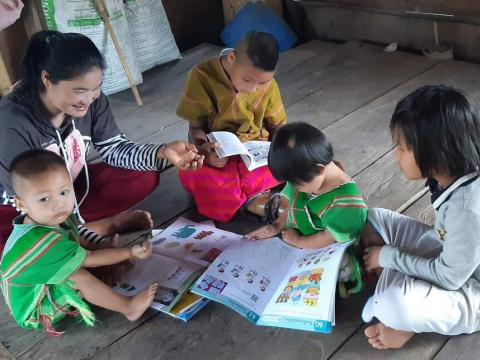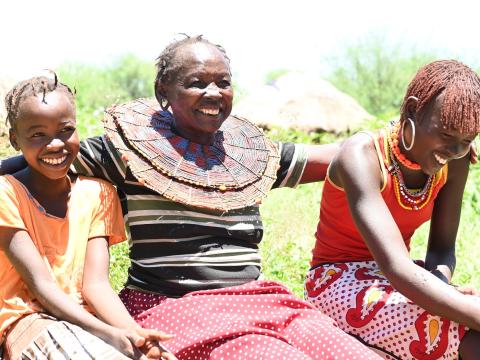It takes more than laws to end violence against children
Mirela explains that it takes more than people knowing there is a law preventing violence against children to stop them beating their children, it takes social and behaviour change.
Dr Mirela Oprea, Social Norms and Behaviour Change Advisor, World Vision
As it is in many other nations, violence against children is forbidden in my country. There is a special piece of legislation that enshrines children’s right to be protected from every possible form of violence. Parents are therefore not allowed, under any circumstance, to beat their children, to force them to marry, to insult them, to use them to satisfy their sexual urges, or harm them in any other way.
But just today, I learned about one of my countrymen who couldn’t care less about the law: two of his children met his belt. This kind of 'discipline' is sadly all too common in my country. The law that expressly forbids beating children is rarely saving a child from an angry parent because children are considered little more than property.
The saying goes: “It’s me who made you, it’s me who kills you."
Banning violence against children via legislation is a huge step forward and it surely contributes to reducing violence against them, giving a strong signal that harmful practices have to stop. But the fact that there are 2 billion children in the world who are still victims of violence, tells us that more is needed.
Unfortunately citizens rarely change their behaviours just because a new law is passed, especially when that law is not properly enforced and when it conflicts with entrenched social norms. If it is true that culture eats strategy for breakfast, old habits and social norms eat new laws for lunch.
For people to change harmful behaviours towards children, what is needed is for legislation to be accompanied by solid social and behaviour change strategies.
Behaviour change strategies are like the "last mile" in technology projects, as professor Sendhil Mullainathan says in this fascinating Ted Talk. The "last mile" represents the stubborn final stretch to completely achieve a goal.
Social and behaviour change is a meta-discipline that employs insights from a variety of disciplines (psychology, communication, anthropology, neuroscience, sociology, etc.) to foster a deep understanding of human behaviour. The truth is that adults have a variety of reason they think it is OK to behave violently with children:
- because “this is how we raise children in this community” (descriptive social norm),
- because “my neighbours expect me to discipline my children” (injunctive social norm),
- because the Bible clearly says “spare the rod and spoil the child” (it’s God’s will),
- because “I was also spanked and I turned out alright” (unprocessed trans-generational trauma),
- because “my children are so naughty that they make me beat them” (blaming the victim),
- because “this is the only thing that works” (low self-efficacy),
- because "children will forget anyway" (low perceived risk),
- because “I feel like exploding” (anger management),
- because “nothing else works” (action efficacy), etc.
Traditionally, all these reasons have been tackled using a communication-driven approaches: tell people how harmful their approach is and they will do the right thing. The assumption behind this logic is that people are rational beings and that there is a knowledge deficit--they don't know better. But it ignores all the real-world, complex issues listed above.
Social and behaviour change rather uses evidence-based interventions at the individual, community, and societal levels to support the adoption of healthy practices.
For example, social and behaviour change professionals may conduct a Barrier Analysis study to understand why the desired behaviour (using positive parenting skills instead of violent discipline) is consistently failing.
A group of parents who already use positive parenting skills is compared with a group of people who use violent discipline, in an effort to uncover the so-called “behavioural determinants”. The question is: which reasons (such as the above-mentioned ones) are most relevant for the group of parents who do not practice the desired behaviour? Subsequently, services, programmes and interventions are informed by the answer to this crucial question and tailored to specifically address the relevant drivers of the harmful behaviours.
In an irrational world, social and behaviour change is the rational thing to do. Many NGOs, philanthropists and child rights activists have already started to harness the power of behaviour science to address the huge plight of violence against children. And still, some critical barriers remain:
- A lack of understanding of the “last mile problem" and the belief that a combination of legislation with prevention and intervention services will be enough. (It’s not: parents ignore well-meaning legislation and will unlikely visit those services);
- A lack of awareness of the body of supporting evidence, combined with the idea that violence against children is unsolvable. (Not true: there are countries in the world with very low levels of violence against children);
- A misunderstanding of what constitutes high-quality social and behaviour change, with the supposition that awareness-raising is sufficient. (It’s not, given that knowledge is not the real problem) and a focus on short-term results.
But these barriers are worth striving to eliminate, not only because this is the moral thing to do, but also because in many cases they truly represent that last mile before an end to violence against children.
Mirela Oprea is World Vision's Social Norms and Behaviour Change Advisor. She describes herself as "fascinated by how change happens" and in her work she seeks to harness the science of behaviour change to end violence against children. Follower on Twitter at @miruoprea

